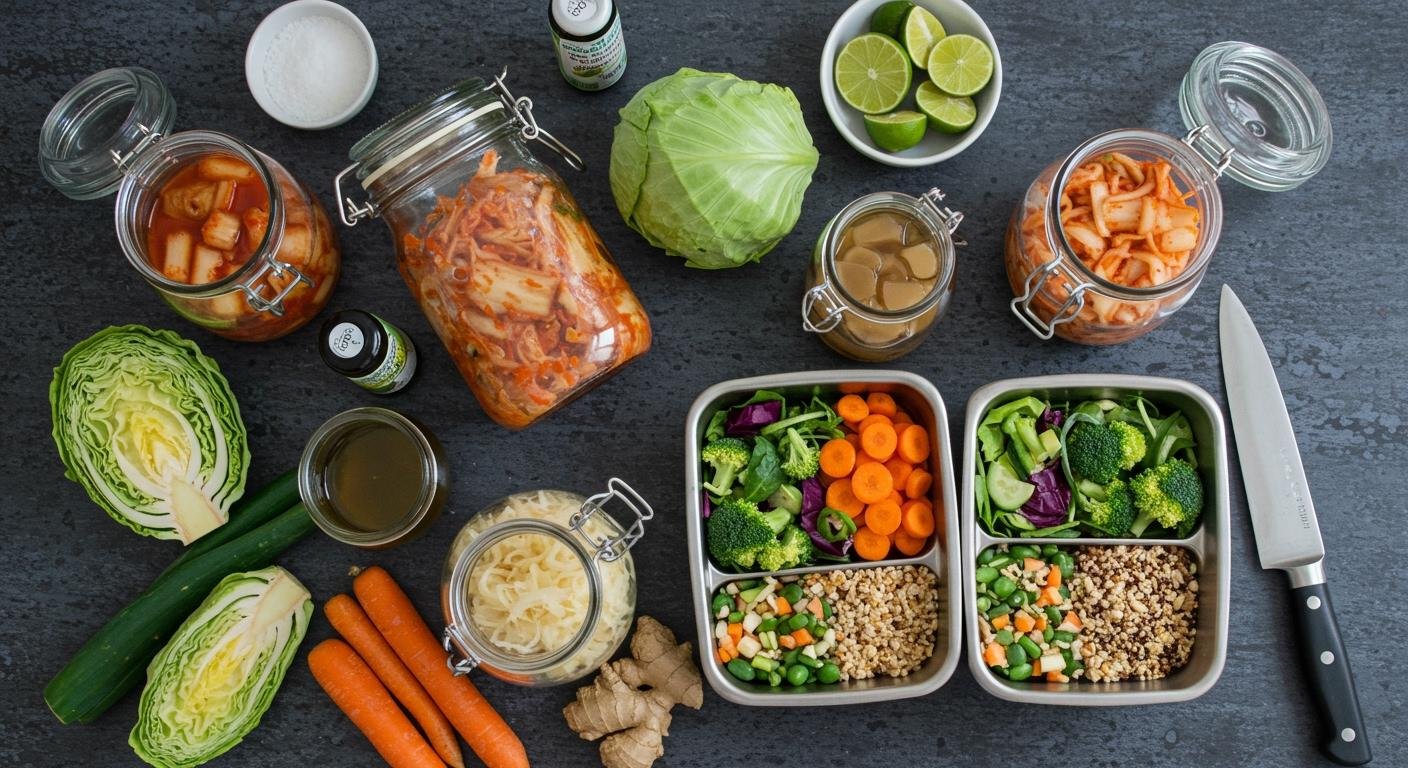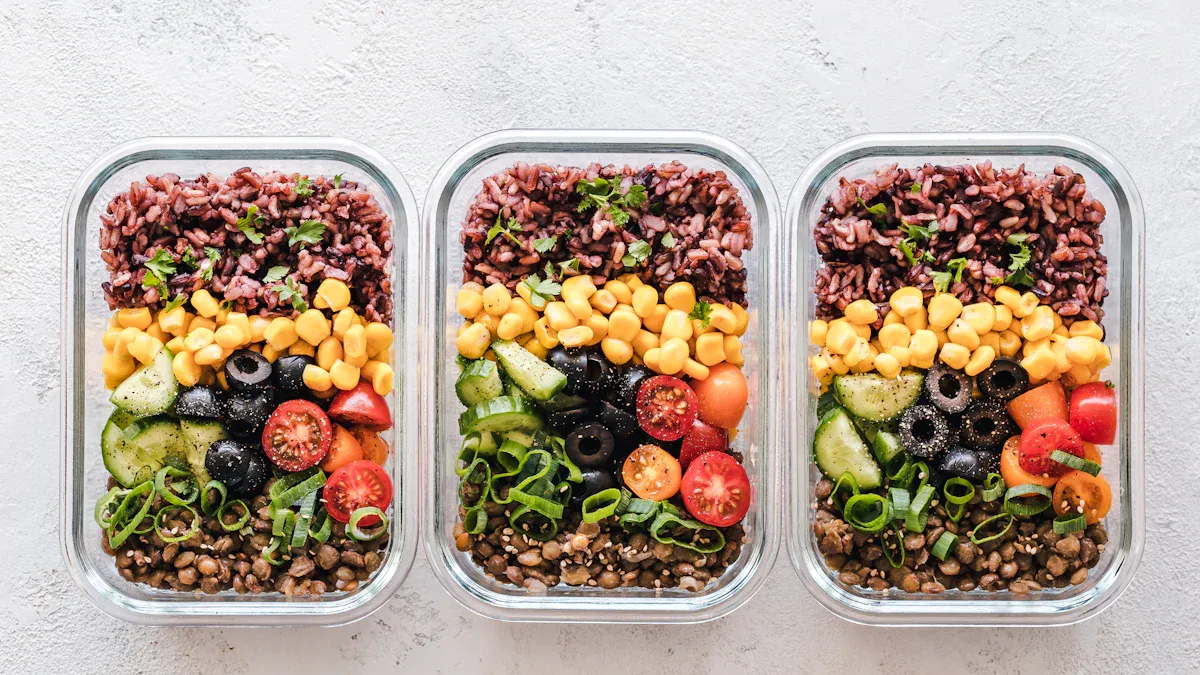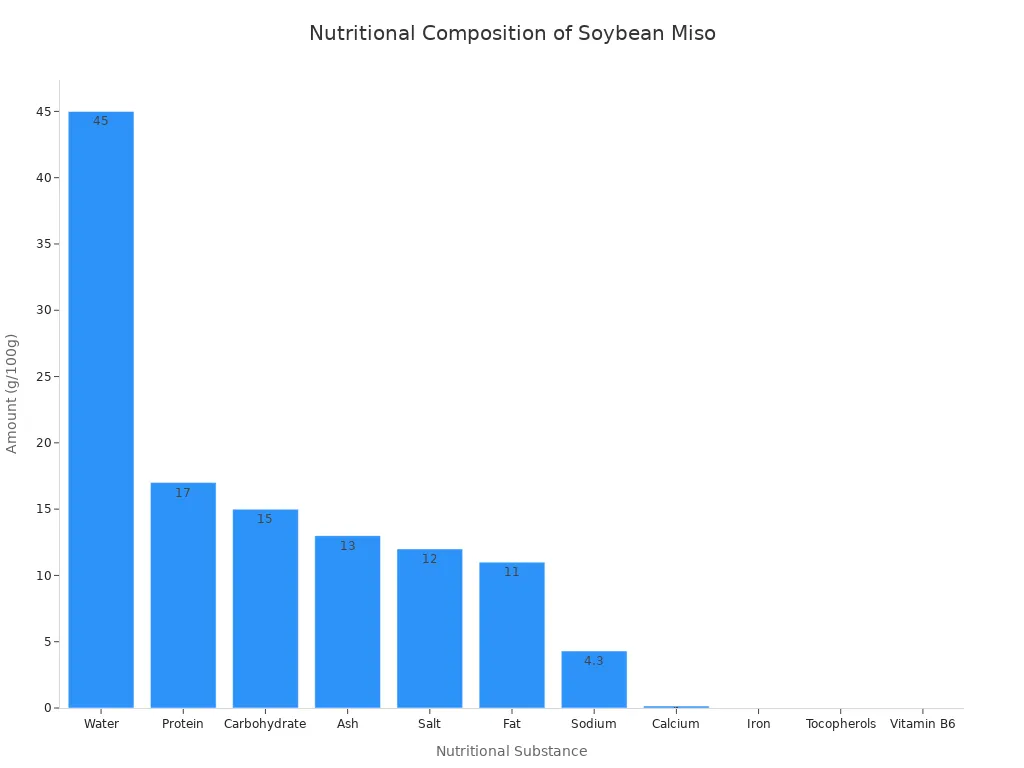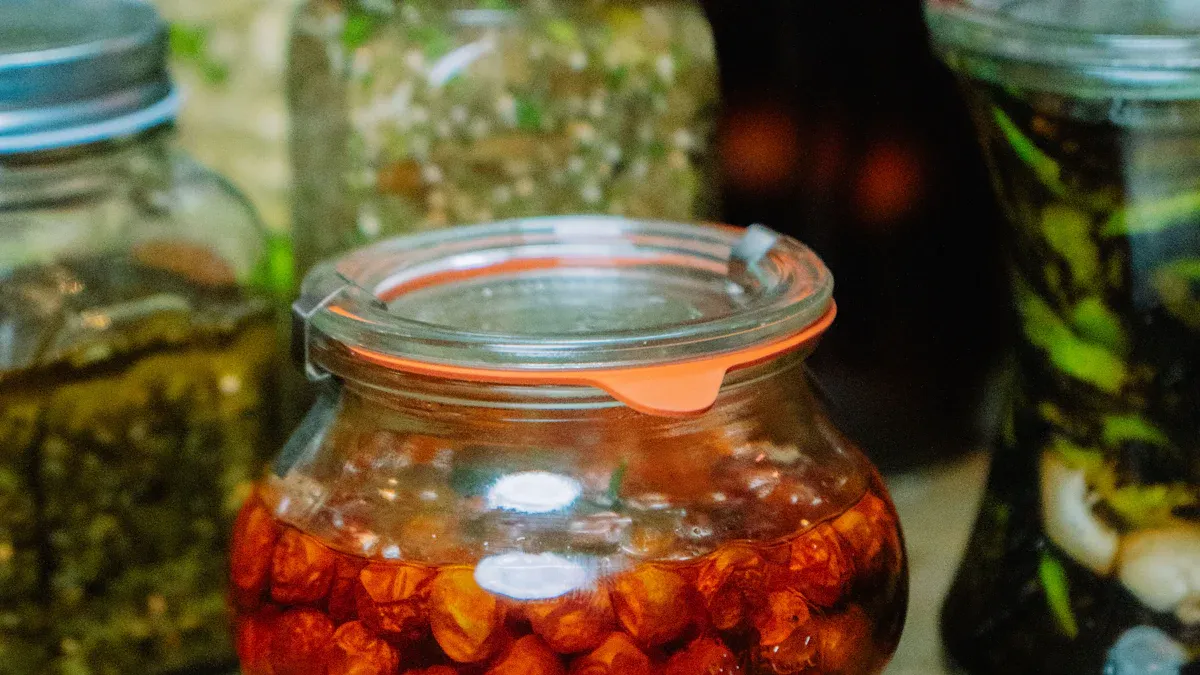My Meal Prep Journey With Fermented Foods
Table of Contents

I once found fermented foods intimidating, but now they are a staple in my healthy meal prep. You are not alone in your interest; a recent survey shows 75% of consumers want foods that improve gut health. This meal plan is your perfect start. Your weekly meal planning for a tasty meal begins with this simple 3-day plan. This meal prep guide uses fermented ingredients for each meal.
| Day | Breakfast Meal | Lunch Meal | Dinner Meal |
|---|---|---|---|
| 1 | Oatmeal with Kefir | Quinoa Salad with Sauerkraut | Chicken & Veggies with Kimchi |
| 2 | Yogurt with Kefir | Leftover Quinoa Salad | Salmon with Miso-Glazed Asparagus |
| 3 | Eggs with Kimchi | Leftover Chicken & Veggies | Lentil Soup with Yogurt |
Did You Know? The global market for fermented foods is booming. This shows just how many people are adding fermented items to their diets. | Metric | Value | |—|—| | Market Size in 2024 | USD 247.16 billion | | Projected Market Size by 2034 | USD 398.78 billion |
Weekend Meal Prep Basics

A successful week starts with a solid plan. Your weekend meal prep session is where the magic happens. You will prepare the core components for each meal. This makes weekday assembly fast and simple.
Cook Grains & Proteins
You should cook your grains and proteins in one batch.
- Quinoa: Cook 1 cup of dry quinoa according to package directions. This yields about 3 cups cooked. Let it cool completely before storing.
- Chicken: Bake two chicken breasts at 400°F (200°C) for 20-25 minutes. Let them rest before dicing.
- Salmon: Bake two salmon fillets at 400°F (200°C) for 12-15 minutes.
Pro Tip: To keep salmon moist when reheating, add a little water and cover it. Reheat it slowly in the oven at a low temperature. This prevents your delicious meal from drying out.
Chop Your Vegetables
Properly prepped vegetables make any meal easier. You should wash and chop your produce for the week.
- Dice one bell pepper and one onion. Store them in a sealed container in the refrigerator.
- Trim the ends off a bunch of asparagus. Hearty vegetables like bell peppers, onions, and asparagus hold their texture well. This makes them perfect for meal planning.
Select Your Toppers
Fermented foods are the stars of this meal prep plan. You can find these items in the refrigerated section of most grocery stores. Look for labels that say “raw,” “unpasteurized,” or “live active cultures.” This ensures you get the full benefits of these fermented products. This plan uses three key fermented foods:
- Sauerkraut
- Kimchi
- Kefir
DIY Sauerkraut Basics
You can easily make your own fermented cabbage. This process is called fermentation.
- Finely shred one head of cabbage.
- In a large bowl, massage 2 tablespoons of salt into the cabbage until it releases liquid (brine).
- Pack the cabbage tightly into a jar. Ensure the brine covers the cabbage completely. This is crucial for safe fermentation.
- Seal the jar and let the fermentation process begin. Store it in a cool, dark place for at least 3 days before tasting. Your first homemade fermented meal is that simple.
Your 3-Day Assembly Plan
You have completed your weekend meal prep. Now you can enjoy the rewards. This section shows you how to assemble your prepped ingredients into delicious meals. This simple plan makes your weekday meal planning effortless. You will see how easy it is to create flavorful, gut-friendly recipes.
Day 1: Probiotic Kickstart
Your first day introduces a variety of fermented foods to your diet. Each meal is designed for flavor and function.
-
Breakfast: Oatmeal with Kefir Your first meal combines fiber and probiotics. Gently warm a serving of oatmeal. Pour about half a cup of kefir over the top. Kefir contains up to 61 strains of beneficial bacteria and yeasts. This makes it a very diverse probiotic source. The combination of probiotic kefir and prebiotic oats creates a powerhouse breakfast for your gut health.
-
Lunch: Quinoa Salad with Sauerkraut This lunch is a refreshing and crunchy meal.
- Combine 1.5 cups of your cooked quinoa with the diced bell peppers and onions.
- Add a tablespoon of your sauerkraut. This small serving size is effective for improving digestion.
- Drizzle with a simple vinaigrette. Toss everything together for a quick and satisfying meal. You can also add other ingredients like chopped kale or cannellini beans to these recipes.
-
Dinner: Chicken & Veggies with Kimchi You will love this simple yet flavorful dinner meal. Reheat one diced chicken breast and a portion of your chopped vegetables. Serve it with a scoop of kimchi on the side. Kimchi adds a delicious savory and spicy quality to the meal. Its flavor provides a wonderful new dimension to roasted chicken without being overpowering.
A Gut-Friendly Tip For the best results, you should eat fermented foods “little and often.” A small serving with each meal helps continuously energize your gut microbes. This plan helps you achieve that consistency.
Day 2: Gut-Friendly Flavors
Day two continues your journey with new flavor combinations. You will use leftovers from day one to save time.
-
Breakfast: Yogurt with Kefir This is a quick and easy breakfast meal. Mix plain Greek yogurt with a splash of kefir for an extra probiotic boost. You can add berries or a sprinkle of nuts for texture.
-
Lunch: Leftover Quinoa Salad Enjoy your pre-made quinoa salad from yesterday. The flavors often taste even better the next day. This is the beauty of good meal planning.
-
Dinner: Salmon with Miso-Glazed Asparagus Tonight’s dinner meal features the rich, umami flavor of miso. Miso is a fermented soybean product full of nutrients. The fermentation process enhances its nutritional value.

Follow these simple steps for one of the tastiest salmon recipes:
- Create a quick glaze. Whisk together 1 teaspoon of miso paste, 1 teaspoon of soy sauce, and ½ teaspoon of sesame oil.
- Brush the glaze over your pre-cooked salmon fillet and asparagus.
- Reheat in the oven at 350°F (175°C) for 5-7 minutes, or until just warmed through.
Day 3: Simple and Satisfying
You have reached the final day of the plan. These recipes are simple, satisfying, and packed with goodness.
-
Breakfast: Eggs with Kimchi Start your day with a zesty kick.
- Sauté a tablespoon of chopped kimchi in a pan for one minute. Using aged kimchi provides a more intense flavor.
- Add two whisked eggs to the pan. Scramble them with the kimchi until cooked.
- Adding kimchi to eggs introduces beneficial probiotics, iron, and vitamin K to your meal. This is one of the most popular fermented recipes.
-
Lunch: Leftover Chicken & Veggies Your final lunch is another time-saver. Enjoy your remaining portion of chicken and vegetables. You can add a spoonful of kimchi or sauerkraut for extra flavor.
-
Dinner: Lentil Soup with Yogurt This final meal is pure comfort. Heat up a bowl of your favorite pre-made or canned lentil soup. Swirl in a large spoonful of plain Greek yogurt or kefir before serving. The yogurt adds a creamy texture and a tangy flavor that balances the earthy lentils. It is a perfect end to your 3-day fermented food journey.
Benefits of Fermented Foods

Adding fermented foods to your diet offers more than just new flavors. You are also improving your health from the inside out. The process of fermentation transforms food, unlocking powerful benefits for your body. This transformation boosts the food’s overall nutrition.
Improved Digestion
You can improve your digestion with fermented foods. These foods contain live microorganisms, or probiotics. Probiotics like Lactobacillus strains help balance the good bacteria in your gut. A healthy gut microbiome is essential for proper digestion. The fermentation process makes the nutrition in food easier for your body to absorb. Naturally fermented foods like yogurt and kefir strengthen your digestive system and help it run smoothly.
A Healthy Gut Tip 💡 The live cultures in fermented foods are key. They help your body maintain a healthy intestinal microflora balance, which is crucial for good gut health and better nutrition absorption.
Boosted Immunity
A healthy gut supports a strong immune system. Fermented foods can help you build that foundation. The fermentation process can create compounds that reduce inflammation in your body. Studies show that eating fermented foods regularly can lower levels of inflammatory proteins. For example, one study found that a diet high in fermented foods reduced 19 different inflammatory markers. Kefir has also shown promise in studies for boosting immune responses. This makes these foods a great choice for creating immune-boosting meals and improving your overall nutrition.
Enhanced Flavor
Fermentation creates amazing, complex flavors. This natural process makes food more delicious. During fermentation, bacteria break down proteins into amino acids. One of these amino acids is glutamic acid, which gives food a savory, umami taste. This is why kimchi has such a bold flavor. The fermentation also produces a pleasant sourness, adding another layer of taste. This process not only enhances flavor but also improves the food’s nutrition profile, making your meals both tasty and healthy.
This meal prep plan shows how to make a quick meal. You can create a delicious fermented meal with this plan. This meal plan is a great start for your meal planning. Feel free to experiment with each meal. Try new fermented foods with your next meal.
What is your favorite fermented meal? Share your best meal idea in the comments below. Let’s discuss your next meal! 💬
FAQ
Can I use other fermented foods in this plan?
Absolutely. You can explore many foods made by fermentation. Try swapping sauerkraut for beet kvass in a salad dressing. You could also use tempeh instead of chicken. Feel free to experiment with different flavors and find what you enjoy most.
How do I know if my homemade fermentation is safe?
Trust your senses. A successful fermentation smells pleasantly sour. Unsafe fermentation often has a bad odor or visible mold on the surface. If it smells rotten or looks fuzzy, you must discard it. Your safety is the top priority.
Will cooking fermented foods destroy the probiotics?
Yes, high heat destroys the live cultures from fermentation. You should add foods like kimchi or yogurt to meals after cooking. However, the fermentation process also adds flavor and nutrients that remain after cooking, so you still get some benefits.
How much fermented food should I eat daily?
You can start with a small amount, like one or two tablespoons per meal. This helps your body adjust to the fermentation. Pay attention to how you feel. You can gradually increase the amount as your digestive system gets used to the new foods.

Poseidon
Master of Nutritional Epidemiology, University of Copenhagen, Herbal Functional Nutrition Researcher
Focus: The scientific application of natural active ingredients such as Tongo Ali, Horny Goat Weed, and Maca to sexual health and metabolic regulation.
Core Focus:
Men: Use a combination of Tongo Ali (an energizing factor) + Maca (an energy reserve) to improve low energy and fluctuating libido.
Women: Use a combination of Horny Goat Weed (a gentle regulator) + Maca (a nutritional synergist) to alleviate low libido and hormonal imbalances.
Stressed/Middle-Aged Adults: This triple-ingredient synergy supports metabolism, physical strength, and intimacy.
Product Concept:
Based on traditional applications and modern research (e.g., Tongo Ali promotes testosterone-enhancing enzyme activity, and icariin provides gentle regulation), we preserve core active ingredients and eschew conceptual packaging—using natural ingredients to address specific needs.
Simply put: I'm a nutritionist who understands "herbal actives." I use scientifically proven ingredients like Tongo Ali, Epimedium, and Maca to help you make "sexual health" and "nutritional support" a daily routine.
